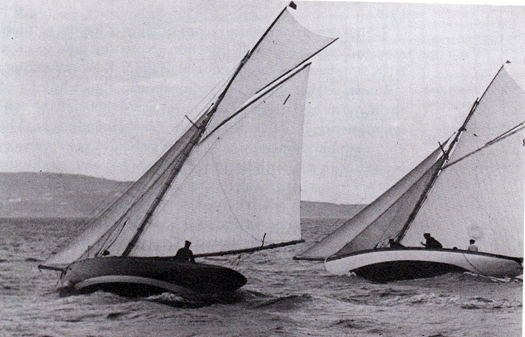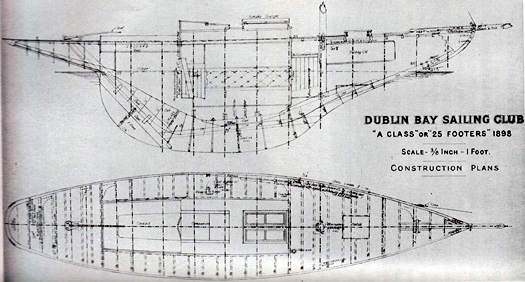Concha, Dublin Bay 25

The Twenty-Fives were conceived by the Dublin Bay Sailing Club around 1898, and designed by the great Scottish designer, William Fife.

What follows is an extract from the history of the Dublin Bay Sailing Club:
THE TWENTY FIVE FOOTERS
The DBSC committee came up with the Twenty-Five Footer, unquestionably Dublin Bay’s own most successful keelboat, still remembered with affection by older members of the Club. No yacht is ever completely original in conception and it is no secret that the inspiration for the Twenty-Fives came from the north of Ireland. Just about the time that the Club started to cast around in search of a new boat word came that the Royal Ulster Yacht Club was launching a most interesting craft. This was the Belfast One-Design — 25 ft on the water line, 37 ft overall, sail area 848 sq. ft, with a coach roof and a skylight, designed by Fife and built by John Hilditch of Carrickfergus. A large-bodied boat, with a headroom of 5 ft 9 ins., she could be used for either racing or cruising.
When the Belfast boats came south to participate in the Royal Irish Regatta in July 1897, the DBSC committee arranged a special race so that interested members could take a look at them. Impressed, the Club at its October meeting passed a resolution setting up the D.B.S.C. Twenty-Five Foot Class. The projected design followed very closely the lines of the Belfast boat. The principal difference lay in the timbers — grown, instead of steamed, and in the keel, which in the Dublin Bay boats was to be of lead instead of iron. This was a detail which was to cause a lot of trouble. It is interesting that the secretary of the Belfast Lough One Designs, with whom the D.B.S.C. corresponded on this occasion, was James Craig, afterwards Viscount Craigavon, and the first Stormont Prime Minister.
The designer, the famous William Fife, junior, must sometimes have wondered whether the game was really worth the candle, for the Dublin Bay Sailing Club proved to be among the most demanding of clients. Here is an extract from a list of queries raised on the specification he had suggested for the boat:
Deck Beams: Define what you mean by ‘root cuts’. Do you mean beam and knee to be in one piece? Or do you mean the beam to be cut out of the lower part of the tree? If you mean the first (and, as it would be difficult to procure same in Ireland) would you approve of oak knees being optional?
Fastenings: Muntz metal bolts for deadwood preferred. Keel bolts of copper. Planking — omit Muntz metal spikes. Butts to be fastened with brass or copper screw nails….
Smith Work: Steel tiller. A spider band arrangement preferred. Query one iron shoe pin to work in hole in iron keel for bottom of rudder — should it read ‘gun metal and lead keel etc.’
The source of this expertise was probably P. G. Hollwey of the boatbuilding firm, a member since 1893, who joined the committee to assist in these particular deliberations.
Things started to get awkward indeed when James Doyle, who was building the
first Twenty-Five Footers (Nepenthe, Dart, Hula and Whisper) reported that the
lead keels, cast in accordance with Fife’s design, were underweight. Fife’s advice
to the committee was that in his experience lead keels can vary much in weight
— the solution was not to reject the keels but to put extra lead inside the
boat in a position to be assigned by the measurers. Further debate ensued when
it emerged that none of the boats, built as they were strictly in accordance
with the specification, had the required load waterline of twenty-five feet.
Ultimately, the committee had to be satisfied with a load waterline ranging
between 26 ft 1 in. and 26 ft 3 ins. Fife’s explanation for all of this they
judged to be ‘most unsatisfactory’.
This, strictly, should have made the Twenty-Fives Twenty-Sixes but no one ever
seriously thought of altering the title. Indeed, policing the one-design
concept, as many others were to discover before the introduction of
production-series yachts, gave the Committee more than enough to think about.
Quite a stern line had to be taken on what at first looked like minor
deviations — even on the part of some who regarded themselves as senior members
of the Club.
Yet for all these teething troubles the Twenty-Fives were undoubtedly a great success — certainly during their early years. The first boats, built by James Doyle, were launched in May 1898 and some of the boats were racing well into the ‘forties and ‘fifties. The last reference to a Twenty-Five in the records of the Club occurs in 1962, when it was reported to the committee that the much-loved “Punctilio” had been sold away from Dublin Bay.
“Punctilio” had been originally built by Sibbick for Mr. Sebastian Nolan who sold her at the end of the first season to John Stephens and George Arthur Newsom. Here he was a bit precipitate because in 1903, when the Viceroy, Lord Dudley, joined the class, Mr. Nolan, understandably, had to buy a new boat. “Punctilio”, after a few indifferent seasons in the hands of Newsome and Stephens went on to become one of the most successful boats of the Dublin Bay fleet.
Another famous Twenty-Five was the “Fodhla” — still remembered by the Dun Laoghaire boatmen as “The Foddla” — which was built by Doyle for the Viceroy in 1903. The Gaelic Revival being fashionable at the time, Lord Dudley had her name inscribed in Gaelic lettering on her hull. There is a sort of a tradition that she was originally intended by Lady Dudley as a birthday present for her husband and that he accidentally discovered this on a visit to Doyle’s yard. On that occasion, the noble lord, in his casual aristocratic way, is supposed to have said to Lady Dudley: ‘I was wondering why you were pinching Doyle’s arse.’
It is possible that this scion of the English aristocracy, enormously rich and a close friend of Edward the Seventh, found his own appropriate level when he joined the Dublin Bay Sailing Club. On one occasion he is reputed to have been knocked overboard by a boom when enjoying a glass of whiskey after a race. When he was hauled back on board, still clutching his glass, he is said to have boasted: ‘And I never spilt a bloody drop’. |
Lord Dudley certainly seems to have enjoyed racing in Dublin Bay. In due course, when the swings of political fortune put his party out of office, the crew of “The Fodhla” were invited to say farewell to him at the Castle. He told them that he had enjoyed sailing with them so much that he intended to give them a little present. And the little present was “The Fodhla”.
Some of the Twenty-Five men lived adventurous lives. “Punctilio” went aground at Coliemore but floated off. “Mavis” left her natural element in Dun Laoghaire and came ashore, scattering the spectators on the pier. “Lady Disdain”, nee “Whisper”, dragged her anchor in a gale of wind and was wrecked off the Kerry coast. “Alanna” was lost off the Isle of Man. “Acushia” was wrecked at the nose of Howth. “Nepenthe”, which was raced well into the ‘forties, was eventually sunk after a collision. The redoubtable Seymour Cresswell was on board at the time and, it is said, had to jump for his life. The boat which collided with “Nepenthe” was the “Blue Trout”, sailed by a certain Mr. Bingham. In consequence of this misfortune that gentleman was always referred to by the waterfront boatmen as ‘Bingham, Bang ’em and Sink ’em’.
“Concha” is currently in the Aldeburgh Boatyard, and in need of a full restoration.
